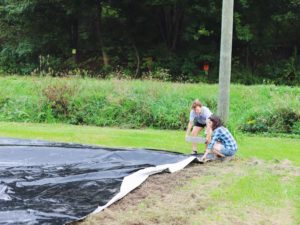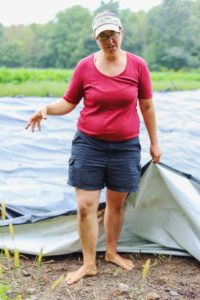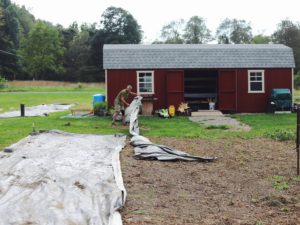Local Farms Trial Tarping for Reduced Tillage Research
As the growing season winds down, Haley Rylander, a masters student working with the reduced tillage project of the Cornell Small Farms Program, has been visiting with farmers who have taken an active role in her research. Haley shares some of these farmers’ experiences and gives insight about using tarps to suppress weeds and reduce tillage on small farms.
There are few foolproof methods to control weeds, especially in organic agriculture where farmers cannot use herbicides. For these farmers, tillage is one of the best ways to reduce weed pressure, but intensive tillage degrades soil structure over time and leads to loss of organic matter and moisture from the soil. The reduced-tillage project team at the Cornell Small Farms Program have been talking with farmers in the northeast who are experimenting with innovative solutions to reduce weed pressure and conserve soil health in organic systems. We’ve been doing some research trials with one of these tools: black silage tarps placed on the soil surface prior to planting.
These tarps smother living weeds and can encourage the seed bank of other weeds to fatally germinate. Tarps also prevent leaching of nutrients and conserve moisture, while slightly heating the soil. Tarps can be used in combination with low-disturbance tillage to provide many of the same benefits as intensive tillage. The initial results of this research was recently published on eXtension.org.
To supplement our trials at Cornell University’s Thompson Research Farm, we’ve been doing some on-farm trials with local growers in Central New York to see how tarps perform in real situations on real farms. Over the last few weeks, we’ve visited some of these farms to see how things have progressed as we near the end of the season. Three of these farms are local to the Cornell campus in Ithaca, NY: Centurion Farm, Muddy Fingers Farm, and Ploughbreak Farm.
These farmers used tarps for different lengths of time and on different crops, with whatever pre- or post-treatment of the soil they chose. Some tilled lightly before the tarps were applied, some tilled after, some had mowed cover crops before hand. It was all up to the farmers, as long as they used a tarp over a number of beds and compared their weed pressure and yield to that of un-tarped beds nearby.
From talking with these farmers about their experience with the trials, we have found some common themes. One of which is that tarps hold soil moisture at an ideal level.
“A drier area stayed pretty dry, even in rainstorms, and if it was a wetter area, the moisture sort of evened out,” Aaron Munzer from Ploughbreak Farm said of the soil moisture under tarps. “So it was actually pretty perfect for tillage or planting.”
Liz Martin from Muddy Fingers Farm planted beets in this year’s very dry July, and attributes her higher stands in tarped beds compared with untarped beds to better soil moisture.
One of the biggest benefits of tarps is their ability to suppress weeds. Nina Saeli from Centurion Farm said that the weed suppression alone makes the tarps worth it.
“I timed myself when I weeded, on the tarped beans, it literally took me more time to walk the beds to look for weeds than it took me to actually weed,” Nina said. “On the untarped side with the beans, it was much more difficult, and I spent a lot more time weeding … once I let that side get a little away from me, I was on my hands and knees pulling those weeds up when I was not doing that on the tarped side.”
Several of the farmers commented on the ability of tarps to control perennial weeds, though it may take many more weeks or even months longer than the three weeks required to kill most annuals. Weed suppression from tarps does not seem to be a season-long effect. However, Liz said it was fun to see how clean she could get her beds. She also noted that they had tarped over weeds “and then just left it, and then it’s neat to see how it breaks them down to nothing.”
The farmers say there is definitely a learning curve in terms of figuring out how to incorporate tarps into their cropping plans and determining which crops and timings work best on their farms. In general, prepping beds before tarping seems to have the most positive effects, as tilling after tarping brings up more weed seeds.
Tarps are no miracle solution to eliminate tillage and weeds, but growers seem excited about using them and learning more about the benefits they can provide in a small farming system. When asked their overall opinion of tarping here were some responses:
“It’s a great tool. Even if you’re considering, I recommend people give it a try.” – Liz Martin
“The results we’ve seen so far have encouraged us and we actually went out and bought two tarps.” – Nina Saeli
“I don’t think it’s a perfect solution for a 6-acre farm. I think tillage is still required… on our farm, [but] I think it’s a tool in our tool belt of options to keep weeds down and to practice some reduced tillage.” – Aaron Munzer
For more information on how tarps can be utilized on small farms, visit our project page for additional resources.





Where can I find more information on the material used in these tarps and where to purchase them?
Hi Carol,
I am glad you are interested in incorporating tarps into your system. I would recommend reaching out to Ryan at ryan.maher@cornell.edu and/or Brian at bac11@cornell.edu to learn more about the material used in the tarps and where to purchase them.
I do homestead level farming. When I moved here, the vegetable growing area was an old pasture with various perennial grasses. Even after I hired a neighbor to plow part of the vegetable area, the grass soon recovered and dominated. To say the least, tilling was very difficult and time consuming and it did not really get rid of the grasses.
So, I covered a large part of the vegetable area with heavy black plastic. After a couple months, that got rid of the heavy grass and left that space easily tillable. Weeds eventually migrated to that space, but less than into the rest of the large garden.
I did have a weird experience with an old strawberry area. I had allowed it to become overrun by weeds and by the reemergence of perennial grasses. I covered the area with heavy black plastic and it killed the weeds after about six weeks. However, the strawberry plants were still alive with small yellow leaves. The dead vegetation left a heavy mulch so I threw mustard and clover seeds over the area hoping they would germinate under the mulch. They did. The strawberries have recovered very well, so instead of tilling them, I am leaving them to see what they produce. Hopefully the ground cover will freeze and provide a winter mulch for the strawberries.
The timing for the strawberries is tricky. The ever persistent perennial grasses are coming back. If I left the black plastic longer, it would have probably killed the grasses, but it would also have probably killed the strawberries. Nevertheless, controlling the weeds will no doubt be easier.
Thanks,
Bob Spencer
Thank you for sharing your experience, Bob.